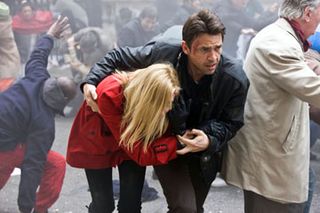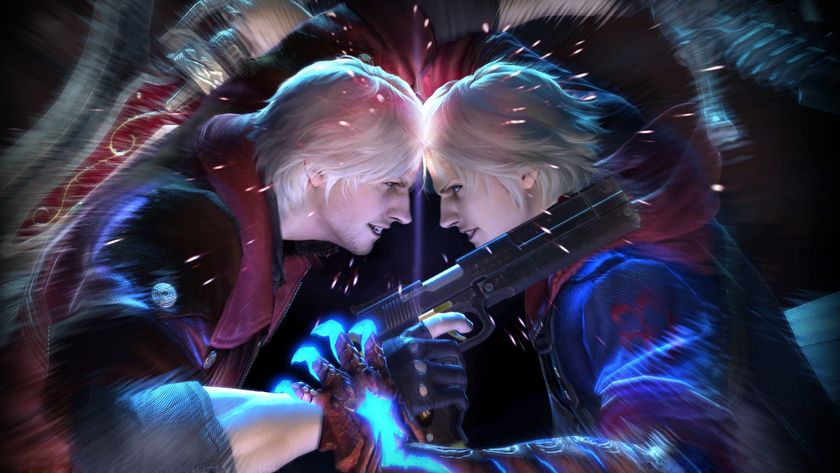
This Christmas isn’t just about Doctor Who. The Beeb is wheeling out a big-budget two-part updating of John Wyndham’s classic post-apocalyptic novel The Day Of The Triffids, with an all-star cast featuring the likes of Dougray Scott, Joely Richardson, Brian Cox, Vanessa Redgrave and Eddie Izzard, and new-look CG killers plants (we’ve had a glimpse and they look great).
It’s set in an alternative near-future where the oil has run out and triffids (carnivorous walking plants with a lethal sting) are farmed for the “triffoil” that now makes the world go round. Unfortunately, with 99 per cent of the world’s population blinded by a cosmic storm and the triffids free to run amok, the planet is in chaos. We spoke to star Dougray Scott, who plays Bill Masen, the most heroic of the remaining one per cent, and producer Stephen Smallwood about their new adaptation.
What attracted you to the part? Were you a fan of the novel?
DS: I think it’s a wonderful novel, beautifully written, and dated but in a beautiful way. I think there’s an innocence to it that I was attracted to, especially the relationship between my character, Bill, and Jo [played by Joely Richardson], which I think is at the heart of our story – this kind of romantic tale between these two people who find themselves in very extraordinary circumstances and are drawn together. Ultimately it’s a love story and a tale of survival, how people react to extraordinary situations – the violence, the compassion, the humanity, the passion... All these themes are there to be explored. I think it’s beautiful.
It’s been nearly 30 year’s since the BBC’s last adaptation of the novel in 1981. What made now the right time to do a new version?
SS: I think that the approach that the writer [Patrick Harbinson] has taken with it is to update it and make it relevant to now. John Wyndham’s novel was written in the 1950s at a time of great fear of nuclear proliferation, of nuclear power plants, nuclear fallout, and although that fear’s not gone away we have other contemporary fears. Updating the novel has tapped into those. Triffids are genetically modified plants, in a world where oil has run out, and contemporary audiences have very specific fears about the world we live in, things like genetic modification, climate change etc. I think a lot of feature films have realised this and tapped into that fear and I think our contemporarisation of The Day Of The Triffids performs the same function. The audience likes to watch it as a cathartic experience – it’s horrifying and scary, but you’ve dealt with the issues a bit by watching it.
Dougray: can you tell us a bit about your character?
DS: He’s a scientist at the triffoil research company. His own personal obsession is communication between the triffids. That’s not relevant to the triffoil companies – all they care about is getting the oil and making it profitable in order to make lots of money and provide the oil and energy that the world has lost through the onset of the global crisis – but his history with triffids goes back to when he was a child in Zaire. His mother and father in our story were both research scientists and were in their own way both obsessed with triffids, and his mother was killed when he was six and his father then went back to England and I guess developed triffoil and made a huge amount of money, but subsequently his relationship with his son became estranged. I think that his obsession with the triffids is born out of the pain he feels for the loss of his mother.
What the world at large doesn’t know is that the triffids are deadly. It’s kind of put about that their sting is like a bee sting but they can kill you if they sting you, and at the beginning of the story he’s in the triffid farm and he intercepts this intruder, an animal rights activist who invades the complex, and he gets stung by a baby triffid in his eyes, so his eyes are taped up and he can’t see anything when the cosmic explosion happens. As a consequence of his eyes being bandaged up he’s not affected by the cosmic explosion which renders 99 per cent of the world’s population blind.
Obviously there’s no such thing as walking carnivorous plants. Was it a difficult challenge to make the triffids convincing?
SS: The script was in development for a long time, and required seeing triffids in flagrante . A long time ago we engaged a designer to design a triffid which would be a walking, fighting, attacking, eating plant, and that’s a big ask of a designer. To be frank, we’ve got the most fantastic cast in this production but if the triffid doesn’t work the production won’t work, and clearly that’s a degree of fear.
Looking back at previous versions of the triffids you laugh at the series in the 1980s, but everybody that I know who saw that was terrified by it. It’s a problem of our advancing expectations, which are affected by feature films that have very, very high-end CGI. We have an enhanced budget but nevertheless we’re making television so we have to try to deliver something that’s very credible and frightening.
Did you have an idea of what you’d be looking at when acting to imaginary triffids on set?
DS: Margaret Thatcher! No, I’m kidding... Nick Copus, the director, did this extraordinary storyboard that he showed me when I first met him, and he would have these kind of animatronic storyboards on his computer that he’d done with the technical guy, and I’d look at that before I’d do a scene to remind myself what it was to be there. That was helpful, but still you’ve got nothing there. It’s bizarre, but it’s fun as well, in a way.
SS: The best sight I saw was Dougray running at an iron bar, which was slightly padded, and wrestling with it and thwacking it with a torch in the most improbable way, but that iron bar turned into a triffid and looks fantastic!
DS: I was fully committed to the task of wrestling an iron bar. It reminded me of Johnny Weissmuller wrestling a rubber crocodile in Tarzan!
Since The Day Of The Triffids was written, loads of movies and TV series have taken a leaf from its book. Do you worry that your TV adaptation might look like it’s imitating them?
SS: We all crave to be original, but we have a source here which is the original novel, and we always go back to the source to find inspiration. So although the novel’s been updated and set in a kind of parallel present or very near future, we go back to the novel for inspiration on most of the things we do.
On a practical level, television finds it hard to compete with the resources that are thrown at a major feature film, so comparing it to I Am Legend where they showed the vegetative overwhelming of New York as time passes, with weeds growing everywhere, putting those in with CGI on every single shot of a townscape would cost a very, very large sum of money. So while we would have liked to do that – and the original script indeed wrote it that way – there was no way we could afford to do that. We do show London in post-apocalyptic state in various key shots to persuade the audience, but we can’t really do it to the same degree as those great iconic movies which have got budgets of about a hundred times more than we have.
Will it be as terrifying to kids as the 1981 series?
DS: There’s two aspects that I think will make the drama work. One obviously is the special effects, and it’s about how good the triffids look and how terrifying they are – there are a lot of expectations in the audience because they’re used to [brilliant CGI], so you can’t do rubber plants being shaken around any more. It has to be a lot more realistic than that. The other aspect is the relationships within the drama, which is what I was mainly concerned with, and they both work hand in hand with each other. But I hope it will be very scary, because it was scary to me as a kid when I was watching it, and CGI didn’t exist in those days. I think people adapt to the times they are in, and yes the expectations are really high now, but you can be very creative.
Sign up to the SFX Newsletter
Get sneak previews, exclusive competitions and details of special events each month!
The Day Of The Triffids airs on BBC One on Monday 28 December and Tuesday 29 December at 9pm.
SFX Magazine is the world's number one sci-fi, fantasy, and horror magazine published by Future PLC. Established in 1995, SFX Magazine prides itself on writing for its fans, welcoming geeks, collectors, and aficionados into its readership for over 25 years. Covering films, TV shows, books, comics, games, merch, and more, SFX Magazine is published every month. If you love it, chances are we do too and you'll find it in SFX.













